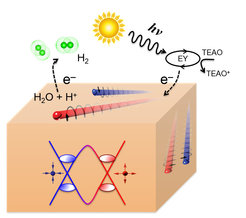Weyl semimetals split water
Catalysis significantly affects our way of life. Catalysis plays an important role in many biological and technological processes. For example, the world’s food supply is based on a famous catalytic process – the Haber Bosch process, that converts hydrogen and nitrogen into ammoniac which is then used as the central ingredient for fertilizers. Gaining improved understanding of catalysis at the fundamental level of atomic orbitals, chemical interactions, energetics and symmetry is a very active field in chemistry.
In this paper, we look at aspects of the catalytic reaction path through the lens of topology. Topology is a new and rapidly expanding field in condensed matter physics and materials science that relates fundamental properties of materials to the underlying topology of their electronic structure. Such an approach should also play an important role in chemistry. Heterogeneous catalysts are based on a wide range of materials that includes insulators, semiconductors and heavy metals. In semiconductors non-trivial topologies give rise to protected, chiral surface states and, in semimetals to Dirac and Weyl cones in the bulk electronic structure and surface electronic properties that are unique. In our first experiments, we have focused on Weyl semimetals since we anticipated that their unique properties, namely a robust Fermi Surface arc and a chiral spin structure, and Weyl points that lead to electrons with extremely high mobilities and mean free paths, should strongly impact their catalytic activities. We have tested our hypothesis using the Weyl semimetals NbP, TaP, NbP, TaAs as catalysts for the hydrogen evolution reaction and have observed excellent catalytic properties. Our work provides a guiding principle for the discovery of novel catalysts from the emerging field of topological materials. This work was carried out in a collaboration between an interdisplicinary team of chemists, physicists and material scientists at the Max Planck Institute for Chemical Physics of Solids, Dresden, and the Max Planck Institute for Microstructure Physics Halle, Germany, and the Jawaharlal Nehru Centre for Advanced Scientific Research, Bangalore, India. Catherine Rajamathi, a Ph.D. student in Dresden and the lead author of the paper, says “I am so pleased to have been able to make a contribution to this study that could have such a profound impact on society to make it more sustainable”.













